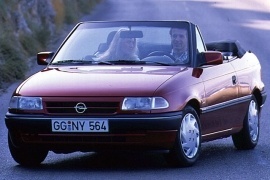
OPEL Astra Cabriolet
Generations Timeline, Specs and Pictures

Opel introduced the second generation of the Astra in 1998 as an affordable compact hatchback for the European market but upgraded it later on and offered it as a convertible since 2000.
After changing the name of its compact contender from Kadett to Astra, the GM’s German arm aimed higher with a coupe and an open-top version, both penned by the Italian design company Bertone. The convertible didn’t look like an econobox anymore and caught the public’s attention with its style and the power-operated roof.
The Italian stylist used the same front fascia from the Coupe, which it designed it as well. With a set of clear-lens headlights and a black grille on the front side of the hood, the Astra Cabriolet offered a near-premium look. Its thick A-pillars served as safety arches as well, and that’s why Opel didn’t have to make an additional protection structure over the B-pillars or behind the rear seats.
Inside, the carmaker used some parts from the rest of the Astra range. Yet, it tried to offer more aluminum and silver trims to enhance the cabin. The white dials in the instrument cluster were carried over from its coupe sibling. Moreover, a set of sport bucket seats with high bolstering was on the options list for the lower-powered versions and standard for the turbocharged models. Despite its short wheelbase, the Astra Cabriolet featured an additional set of seats in the back, which provided enough comfort for short, in-city trips.
Under the hood, the carmaker installed a range of five engines ranged between 103 hp and 190 hp. A 2.2-liter turbo-diesel was available as well.

Opel facelifted Astra’s first generation in 1995, after four years since the model introduction, which improved the convertible version.
Even though the Astra Cabriolet appeared on the market in 1993, the carmaker aligned its timetable with the rest of its stablemates. After all, they all had to look the same and keep a consistent corporate identity. Bertone Studios made the convertible’s original design, and the carmaker didn’t want to spoil it and changed as much as it could without altering the original lines.
The facelifted version received a new front fascia with a redesigned grille that sported a reversed trapezoidal shape and the chromed Opel badge in the middle. In addition, the carmaker installed clear-lens turn signals, dropping the orange ones. A new set of door mirrors replaced the older ones and lowered the wind noise. At the back, the Astra convertible received smoked lenses instead of clear ones.
Inside, the carmaker introduced a new dashboard, which included a passenger airbag. Opel offered an option for a CD player for the top trim levels for the sound system, while the base version received a simple radio tape player.
Under the hood, Opel installed a choice of two engines; a 1.6-liter and a 1.8-liter, both gasoline, and both paired as standard with a five-speed manual and an option for a four-speed automatic.

After the success recorded by Opel with the Kadett Cabriolet, the German carmaker tried to do a sequel for it in the form of the 1993 Astra Cabriolet.
Opel was happy with the new Astra when it introduced it in 1991, but apart from the closed-cabin versions, it needed an open-top one to increase its market image. Even though the convertible market was not very big, it had its customers, and the battle between the Golf and the Astra was taken on any grounds, even with the top down.
The German carmaker decided that it doesn’t have to have a dedicated assembly line for the Astra Cabriolet, so it hired Bertone in Italy to produce them. After all, they had a long relationship, and the small manufacturer was happy to have its production lines filled with a prestigious brand. The Astra Cabriolet featured the same front fascia as the rest of the family, but it was mostly based on the sedan platform, fitted with the lower half of the 3-door version. Unlike the Kadett, it didn’t require a safety arch over the C-pillars.
Bertone designed the car with the idea to completely hide the canvas top behind the rear seats. To do that, it had to push the rear seats forward, and thus the rear seat passengers didn’t have the same legroom as they had in the other Astra versions.
Under the hood, Opel installed a choice of three gasoline engines. A diesel-version was out of the question since it was considered too loud and too smelly for a leisure, open-top vehicle.























































